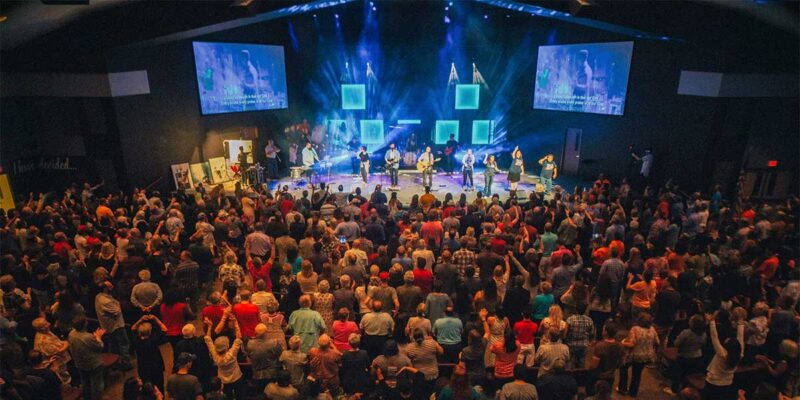Selling AV Technology to Churches: Overcoming Fear, Uncertainty and Doubt
 Fear. Uncertainty. Doubt. We call this ‘FUD’ and it happens all the time for audio, video and lighting sales; one minute the sale looks like it’s about to close and seemingly the next moment FUD strikes and the deal is too often lost. FUD exists in every market within the AV industry, but perhaps it’s most prevalent in the house of worship market, where many of these decisions are handled by well-intentioned volunteers instead of by knowledgeable church AV staff.
Fear. Uncertainty. Doubt. We call this ‘FUD’ and it happens all the time for audio, video and lighting sales; one minute the sale looks like it’s about to close and seemingly the next moment FUD strikes and the deal is too often lost. FUD exists in every market within the AV industry, but perhaps it’s most prevalent in the house of worship market, where many of these decisions are handled by well-intentioned volunteers instead of by knowledgeable church AV staff.
To avoid FUD in the church market, it’s important to not only quell those fears and allay those doubts but to align the church buyer’s decision with their desired outcomes. More often than not, the very fears these decision-makers are worried about can be addressed and debunked through a strong value proposition and the amortization of the cost over many years of church services instead of focusing on a one-time purchase.
Selling Value to Remove FUD from Church Buyers
When the price is the key selling point, you’re running a losing race to the bottom of the sales pipeline, where your company loses no matter what.
“Price is what you sell when you can’t sell value.” — S. Anthony Iannarino
Spend some time with church leaders and you’ll hear what they’re actually talking about when it comes to spending money: stewardship. Churches receive their income from the donations and sacrifice of congregants. As such, the church leaders are not the owners of the money but are instead the stewards who want to spend it responsibly. Like all of us, being wise with finite dollars is always a consideration, but it’s not the point of discussion that a manufacturer or systems integrator should focus on with this vertical market.
With Churches, It’s Not About Price; It’s About Stewardship
Spend some time with church leaders and you’ll hear what they’re actually talking about when it comes to spending money: stewardship. Churches receive their income from the donations and the financial sacrifice of congregants. As such, the church leaders are not the owners of the money but are instead the stewards who want to spend it responsibly. Like all of us, being wise with finite dollars is always a consideration; it just carries a different weight in the house of worship market.
Being a good steward is important to church AV buyers. Because of this, more than a few churches associate good stewardship with cost savings.
Good stewardship is less about how much money was saved and more about how much money wasn’t wasted.
It turns out that money is not really the problem in churches. The perception of good stewardship is the real issue for the men and women responsible for spending donated funds.
So, when the price eventually comes up, help church buyers be good stewards of donated funds and sell them the value of meeting or exceeding their expectations and let price be what it is: the summation of what it takes to create their desired outcome.
Churches have a hard time making purchase decisions when what they want to do and how they need to do it are not well understood and agreed upon.
When a church presents a problem or opportunity for AV technology in their venues, the key is to determine the minimum viable opportunity for success first and then to create further alignment with how the technology can be employed and which technologies will most closely meet or exceed the expectations of the buyer.
Simple Solutions Beat Complex Technology
Simple solutions are not those with less technology, but rather those technologies that combine to align the opportunity with the expectation of the client. When AV salespeople can create an agreement between ‘what’ and ‘how’ for the client, the technology solution will almost sell itself.
Think of it this way: a $50,000 product that can fit an environment for five years (at five services/events per week) before an upgrade is necessary would, amortized, costs $40 per service. Forty bucks! Pretty much every church would pay $40 per service to have the right technology in place to meet their current and foreseeable future needs!
When vendors do not articulate well understood and agreed upon expectations from church buyers, the value of the product or service diminishes. The less clarity there is in defining the scope of work in alignment with the expectation of the decision-maker for the church, the greater the chance of fear, uncertainty and doubt clouding the buying process.
To avoid FUD in the church market, it’s important to not only quell those fears and allay those doubts but to align the church buyer’s decision with their desired outcomes. More often than not, the very fears these decision-makers are worried about can be addressed and debunked through a strong value proposition and the amortization of the cost over many years of church services instead of focusing on a one-time purchase.
Nearly every church buyer is concerned with price, but almost none are concerned with value. The difference is huge and represents the key to aligning expectations to the value proposition of the AV solution so that fear, uncertainty and doubt are addressed and replaced with the confidence of good stewardship spending church funds.
Share your views and opinions in the comments below.





